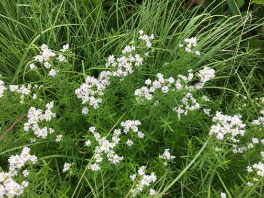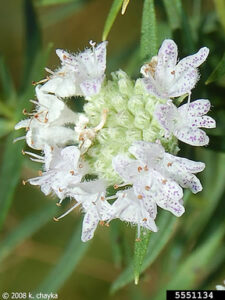Common Mountain Mint
Pycnanthemum virginianum
By Joyce Tuharsky WORC Member

Last year, during our Wild Ones River City (WORC) field trip to the Hudsonville Nature Preserve, I encountered common mountain mint for the first time. I was struck by its pretty white blossoms with purple spots and its lush minty fragrance. So, I was thrilled to get seeds of this plant at our WORC seed exchange in November!
Common mountain mint is a perennial, native to North America from Maine and North Dakota in the north, south to Missouri and North Carolina. The name “mountain mint” is somewhat misleading; since this plant is typically found in moist sand prairies or woodland meadows, fens, and sometimes rocky bluffs.
Like other plants in the mint family (Lamiaceae), common mountain mint has a square stem and opposite leaves; and all parts of the plant are highly aromatic. The leaves are narrowly linear, up to 2½” long, and covered with a whitish bloom. The stems grow 2–3 feet in height, becoming multi-branched toward the top.

The plant’s genus name, Pycnanthemum, means “densely packed flowers” —which aptly describes the dense clusters of tiny flowers that bloom on top the stems. But only a few of the flowers bloom at a time, beginning with the outer circle of flowers and ending towards the center. Each flower is tubular in shape, about 1/8″ long, and 2-lipped. The blooms are highly attractive to pollinators including a wide variety of native bees, honeybees, bumble bees, wasps, flies, beetles, and butterflies. On the other hand, because of its mint fragrance—deer, rabbits, and leaf-chewing insects rarely bother this plant.
Common mountain mint blooms in midsummer, lasting about a month. Afterwards, each small flower produces 4 tiny, finely pitted, black seeds. The root system consists of rhizomes which can spread aggressively, but is less so in drier soil. Clipping will keep this plant in check.
Loam, sand, clay, or gravel—this plant is not fussy about soil texture, but prefers full to partial sun, and wet to average moisture. Common mountain mint is an excellent addition to pollinator gardens, rain gardens, naturalized meadows, shorelines or any moist area. It pairs well with coneflowers, asters, Joe pye weed, spiderwort, penstemon, and native grasses. Like other mints, the leaves of common mountain mint can be used in cooking or tea.
Top photo by Ruth Oldenburg
Detail photo by Katy Chayka, www.minnesotawildflowers.info, Bugwood.org
For more information and photos:
Pycnanthemum virginianum (Virginia Mountain Mint): Minnesota Wildflowers
www.illinoiswildflowers.info/prairie/plantx/cmt_mintx.htm
https://www.gardeningknowhow.com/ornamental/flowers/mountain-mint
